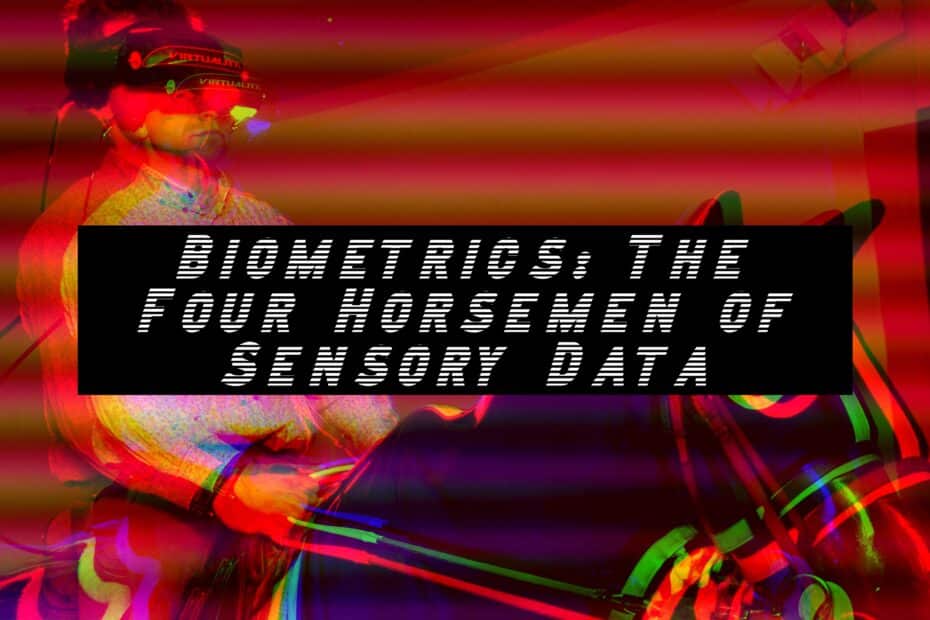Everyone who thinks of biometrics regarding Windows Mixed Reality or virtual reality headsets always assumes you’re talking about security. This is simply because security purposes are the most common uses for biometric data. From fingerprint sensors to the eye or retinal scanners, there is a whole other world out there that’s ripe for the picking!
Here are the four biometric sensors that will find their way into tomorrow’s virtual games and today’s corporate training seminars. Some are more common than others, but their revolutionary uses go beyond what they are being used today.
#1 Biometric Sensor: The VR Heartrate Sensor
While certainly nothing new, the heart rate monitor hasn’t exactly made its way into modern Virtual Reality headsets. Almost! The VR headsets of tomorrow already include the sensor in their marketing material and the uses for this sensor are pretty staggering when you think about it. For gamers, imagine the varying scenarios where you are some spy and need to sneak through an enemy fort going undetected. Alternatively, imagine a hyper-realistic role-playing game or even a first-person shooter where you can run long distances and maximum speed, but for only a certain time. Even for VR-Gym-style games, doing a real workout while monitoring your real health-status can help you stay safe.
For corporate and educational purposes, this adds a tremendously valuable data point. Nearly countless high-risk scenarios will require a stable heart rate to train your mind and body for the real thing. From medical procedures to security scenarios, getting your contractors or employees as close as possible to peak preparedness is priceless. This might actually save people’s lives!
#2 Biometric Sensor: The VR Pupillometry Sensor
This is a big word, but all the pupillometry sensor does is monitor the size of your pupil and the rapid speed at which it changes size. This can be used for similar purposes as the heartrate sensor. Knowing what stimulus triggers, the user can be useful for many scenarios, from games to the medical field. Knowing exactly what aspect of your training makes you the most anxious can narrow down where someone needs additional training for training scenarios.
For the justice system, this might prove useful as a type of lie detector of tomorrow or even a method for testing a driver’s intoxication level. While this might sound like a nightmare to some, others might prefer it as a new option. Specifically, for the VR video games of tomorrow, imagine video games that can learn what fears you have and change the game itself to make it more horrifying for your exact triggers!
#3 Biometric Sensor: The VR Facial Movement Camera
The VR facial movement camera or scanner isn’t exactly new, but the implications and usefulness might have a bigger impact on your life than you realize. Especially in the modern constraints of the virus-filled world, there are a growing need and desire for all things social. Especially the safety of digital social apps!
Seeing and interacting with the facial movements of someone you are having a discussion with is a healthy and normal part of maintaining a conversation. The social media platforms of tomorrow might have an option that will allow you to use your natural facial movements as part of the communication method used!
Imagine how real the role-playing games of tomorrow will be as your charging into battle with your friends and random people, and you can all see the raw movements of each other face on your in-game avatars! This biometric sensor often is associated with violations of privacy, so we will have to be careful to monitor who and what implements such a tool.
#4 Biometric Sensor: VR Eye Tracking Sensor
As the Windows Mixed Reality and VR world in general slowly expands beyond video games, it’s apparent there is a growing class of people who need VR to interact with the world. Beyond those in temporary medically-unfortunate circumstances, there are people with permanent disabilities that can have a new life using the eye-tracking sensor as a modern mouse, reconnecting them with the world. Yes, gamers, not everything is a video game, and not everything is a violation of privacy. Although these aspects can’t be forgotten: remember the goal. Remember the fast-paced games of your childhood dreams of the future, where you’re using your hands to interact with quick menus while your eyes are choosing the next target for your laser gun! It is coming, and it’s almost here!
New Biometric Sensors for WMR and VR Headsets Are Coming
This may just be scratching the surface of what new biometric sensors are coming, but these are the ones currently found on the corporate headsets of tomorrow. Literally, tomorrow, they are available for pre-order now! However, these devices will mostly be used for custom-tailored training experiences for specific purposes, but the tools will become more mainstream. For better or worse, this technology is coming to a VR Headset near you!
